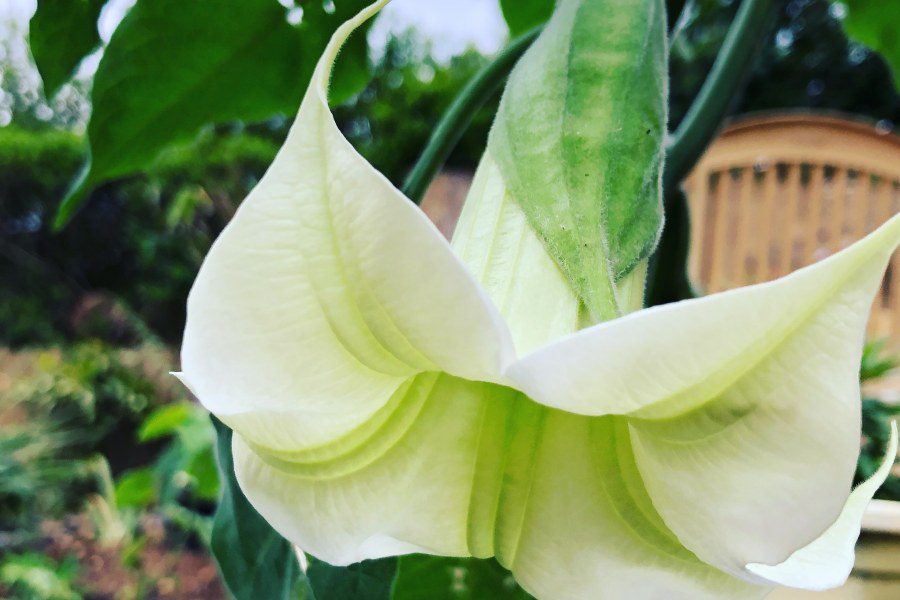Care for Brugmansia (also known as Angel’s Trumpet) in the UK involves several key steps to ensure the plant thrives, given the country’s climate. Here’s a comprehensive guide:
Choosing the right variety of Brugmansia can greatly enhance your garden with its stunning blooms and delightful fragrance. Here are some of the best varieties of Brugmansia to consider for growing in the UK:
Best Brugmansia Varieties
- Brugmansia ‘Charles Grimaldi’
- Description: Known for its large, golden-yellow trumpet flowers that can reach up to 12 inches in length.
- Fragrance: Strong, pleasant fragrance, especially in the evening.
- Growth Habit: Vigorous grower with a bushy form.
- Brugmansia ‘Frosty Pink’
- Description: Features beautiful peach-pink flowers that are slightly recurved.
- Fragrance: Sweet, intoxicating fragrance.
- Growth Habit: Compact and bushy, making it suitable for smaller gardens or container growing.
- Brugmansia ‘Cypress Gardens’
- Description: Boasts large, creamy white to pale yellow flowers.
- Fragrance: Highly fragrant, especially at night.
- Growth Habit: Upright growth habit, often reaching significant heights if not pruned.
- Brugmansia ‘Double White’
- Description: Produces double-layered, white flowers that give a fuller appearance.
- Fragrance: Strong and sweet, more noticeable in the evening.
- Growth Habit: More compact growth compared to some other varieties, ideal for pots.
- Brugmansia ‘Inca Sun’
- Description: Known for its abundant, golden-yellow flowers with a slight peach blush.
- Fragrance: Light, pleasant fragrance.
- Growth Habit: Continuous bloomer and more tolerant of cooler temperatures.
- Brugmansia ‘Versicolor’
- Description: Features large, pendulous flowers that can change color as they age, often starting white and turning to peach or pink.
- Fragrance: Strong, sweet fragrance.
- Growth Habit: Can grow quite large, making it a striking feature plant.
- Brugmansia ‘Sunset’
- Description: Produces beautiful orange flowers with pink edges, giving a sunset-like appearance.
- Fragrance: Sweet, pleasant scent.
- Growth Habit: Vigorous and tall, ideal for creating a tropical effect in the garden.
Tips for Selecting Varieties
- Climate Suitability: Choose varieties that are known for their resilience in cooler climates or that perform well in container growing, as these can be brought indoors during the winter.
- Space: Consider the growth habit of the variety. Compact varieties are better for small gardens or containers, while larger varieties can be used as focal points in bigger spaces.
- Bloom Time: Select varieties with different blooming times to ensure a continuous display of flowers throughout the growing season.
Location and Planting
- Sunlight: Brugmansia thrives in full sun to partial shade. Choose a location that receives plenty of sunlight but offers some protection from strong winds.
- Soil: Plant in well-drained, fertile soil. If planting in pots, use a high-quality potting mix with good drainage.
Watering
- Regular Watering: Keep the soil consistently moist but not waterlogged. During the growing season (spring and summer), water regularly to ensure the plant does not dry out.
- Reduced Watering in Winter: In winter, reduce watering to prevent root rot, especially if the plant is kept indoors or in a greenhouse.
Feeding
- Fertilizing: Feed Brugmansia with a balanced liquid fertilizer every two weeks during the growing season. High-potassium feed can promote more blooms.
Pruning
- Regular Pruning: Prune in late winter or early spring to maintain shape and encourage new growth. Remove any dead or damaged branches.
- Pinching: Pinch back the growing tips to encourage a bushier plant and more flowers.
Overwintering
- Outdoor Plants: In milder areas of the UK, Brugmansia can be grown outdoors. Mulch around the base of the plant to protect the roots from frost. Consider using fleece or other protective coverings during very cold spells.
- Indoor/Greenhouse Plants: In colder regions, it’s best to bring the plant indoors or into a greenhouse. Keep it in a cool, frost-free place with some natural light.
- Dormancy: If kept in a cool, dark place during winter, reduce watering and allow the plant to go dormant. Resume normal care as temperatures warm up in spring.
Pest and Disease Control
- Pests: Watch for common pests like aphids, spider mites, and whiteflies. Treat infestations promptly with insecticidal soap or neem oil.
- Diseases: Ensure good air circulation to prevent fungal diseases. Avoid overhead watering to reduce the risk of leaf spot and powdery mildew.
Repotting
- Frequency: Repot every couple of years or when the plant outgrows its container. Spring is the best time to repot.
- Method: Choose a pot slightly larger than the current one, refresh the potting mix, and ensure the new pot has good drainage.
Take Brugmansia Cuttings
Taking cuttings from Brugmansia is a great way to propagate this beautiful plant. Here’s a step-by-step guide to successfully taking and rooting Brugmansia cuttings:
Materials Needed
- Healthy Brugmansia plant
- Sharp, clean pruning shears or a knife
- Rooting hormone (optional but recommended)
- Small pots or containers
- High-quality potting mix or a mix of perlite and peat moss
- Clear plastic bags or a propagation dome
- Spray bottle for misting
When to Take Cuttings
- Best Time: Late spring to early summer is ideal, although cuttings can be taken throughout the growing season.
Steps for Taking Brugmansia Cuttings
- Select the Cutting:
- Choose a healthy, non-flowering stem that is about 6-8 inches long.
- Ensure the stem is green and not woody, as younger, green stems root more easily.
- Cut the Stem:
- Use sharp, clean pruning shears or a knife to make a clean cut just below a node (the point where leaves attach to the stem).
- Remove any leaves from the lower half of the cutting to prevent rot and reduce moisture loss.
- Prepare the Cutting:
- If desired, dip the cut end of the stem in rooting hormone to encourage faster rooting and prevent fungal infections.
- Plant the Cutting:
- Fill a small pot or container with a well-draining potting mix or a mix of perlite and peat moss.
- Make a hole in the potting mix with a pencil or your finger and insert the cutting about 2-3 inches deep.
- Firm the soil around the cutting to ensure it is stable.
- Create a Humid Environment:
- Mist the cutting with water using a spray bottle.
- Cover the pot with a clear plastic bag or place it under a propagation dome to maintain high humidity. Make sure the plastic does not touch the leaves.
- Provide Proper Conditions:
- Place the pot in a warm, bright location out of direct sunlight.
- Maintain a temperature of around 20-25°C (68-77°F).
- Care for the Cutting:
- Check the cutting regularly and mist it as needed to keep the humidity high.
- Water the soil lightly, ensuring it stays moist but not waterlogged.
- Root Development:
- Roots typically develop in 4-6 weeks. You can check for roots by gently tugging on the cutting; if you feel resistance, roots have formed.
- Transplanting:
- Once the cutting has developed a good root system, it can be transplanted into a larger pot or directly into the garden.
- Gradually acclimate the new plant to outdoor conditions if it was rooted indoors.
Additional Tips
- Sterilize Tools: Always sterilize your cutting tools with rubbing alcohol or a bleach solution to prevent the spread of disease.
- Monitor for Pests and Diseases: Keep an eye on your cuttings for any signs of pests or diseases and address them promptly.
- Label Your Cuttings: If you are taking cuttings from multiple varieties, label them to keep track of which is which.
By following these steps, you can successfully propagate Brugmansia from cuttings and enjoy more of these stunning plants in your garden.
By following these care tips, your Brugmansia can thrive and produce its beautiful, fragrant trumpet-shaped flowers even in the UK’s varying climate.


